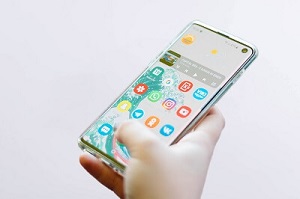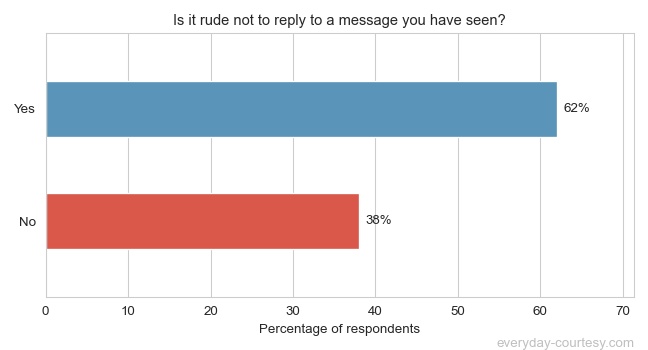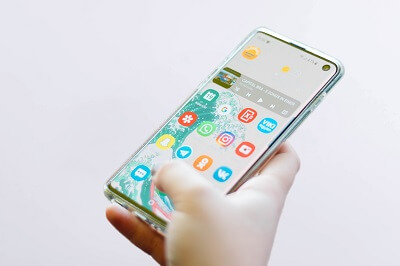Many people nowadays use apps that allow them to communicate with each other via messaging. Although these apps allow individuals to communicate instantly, they don’t support the depth of understanding that’s possible with face-to-face communication.

Things that we sometimes take for granted, such as assuming somebody knows that we’ve read their messages, can lead to hurt feelings and even conflict. Is it rude not to reply to a message even though one can see that you have read the message?
Our Survey
In our recent survey in the United States, 62% of the respondents said it is rude not to reply to a message you have seen. Of 103 respondents questioned, only 38% said it is not rude.

Chances are, if you are interacting with people via messaging and you’re not answering them, roughly two-thirds of all the people who you interact with could be quietly thinking that you’re rude.
Even if they find they think that you’re polite when you interact with them face-to-face, they may find your behavior on digital channels lacking. This can be so even if they’ve known you for years.
It’s important to be polite when you’re using text messaging
Text messaging is just another means of communication. In the same way that in the past there was an established format for writing letters that helped people to make a good impression at all times, it’s important to put your best foot forward when you’re using messaging to interact with others. Being responsive is an important aspect of digital etiquette.
You may unintentionally offend someone who would have become a client or helped your business in some other way. On a personal level, even friends might pull back from you a little if they feel like they’re being ignored. Being ignored hurts a lot and can have a more negative impact on your relationship than arguing. [1]
When you don’t respond to messages you give the impression that you’re too busy to interact with those who are trying to engage with you. While you may be pressed for time, it must be understood that messaging is one of how people nowadays communicate. Take a few seconds to send an emoji or respond in some other way.
Messaging has replaced brief conversations at office doors or in elevators, especially since many people now work remotely. Messaging is used to get things done and when you don’t respond, you can leave the other party feeling confused. Being confused, uncertain, and unsure can cause a person to progress more slowly with an objective not require your input.
If you’ve been asked a question
If you’ve been asked a direct question via messaging, it’s important to respond. For example, you could be asked:
- “What do you think about opening a new branch near to that housing development?”
- “How do you think we can improve sales in the next quarter?”
- “Can we book a vacation for December?”
- “What’s the process for enrolling a child for the new school term?”
In all of the examples above, the person who’s asking the question needs information from you to make a decision.
When you don’t respond, they can’t move forward with their plans.
It appears inconsiderate on your part and may even be interpreted as a deliberate move to hinder their progress.
If you’ve been asked to take action
If someone asks you by a message on a digital channel to take action in some way, they at least expect confirmation that you received the message. For example, if someone asks you to purchase eggs on the way home it’s rude to just not respond.
Even if they know that you read the message they aren’t certain whether you’ll have time to stop by the store, have money to buy eggs, or have another reason why you may not be able to make the purchase.
When someone asks you to take some form of action, it’s appropriate to respond by letting them know that you can or let them know that you can’t.
You may not always have to explain your decision but you should provide them with enough information so that they can have their needs met in another way necessary. They have no way of knowing which factors may be influencing your action or inaction, so it’s important to communicate and not assume that they know exactly what you’re thinking about in the situation.
This applies in both personal and business conversations. For example, if a member of your team asks you to email a report to them, the best way to respond is by replying to their email. Confirm that you’ve seen the request and ensure that the document is attached.
Simply sending the document without any other reply could be interpreted as curt or maybe even leave the individual wondering whether you felt offended by their request or didn’t want to fulfill it. Not responding at all would be interpreted as both rude and unprofessional.
If someone offered praise
In regular face-to-face communication, if someone pays you a compliment it’s good manners to say thank you. That expectation carries over to communication via digital channels as well.
If someone offers praise or commendations for a job well done via an app that you both use, they expect that you will respond in some way. This doesn’t have to be by a line of text. It could be something as simple as an image with a thumbs up.
Some type of response is appropriate. If you don’t respond, the other person may wonder if you appreciated their compliment, since they cannot see you when you quietly smile to yourself. They may even wonder if they’ve somehow been inappropriate in paying you a compliment.
By responding positively, you let them know what you like. You also let them know that their effort to reach out to you was appreciated. You also show a level of graciousness that’s not as easily perceived if you don’t respond at all.
Sources:

Matt Vargas is an author and public speaking coach with a degree in sociology and more than ten years of practical experience. Matt is responsible for the empirical surveys at everyday-courtesy.com, is a passionate recreational musician, and blogs here about his experiences in the field of interpersonal communication.

